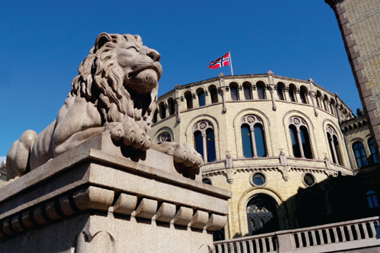The Norwegian government is launching an assessment on how to solve the problem of the domestic and Nordic portion of its sovereign wealth fund hitting limits on the stakes it may hold in companies.
The announcement came in the annual white paper on the entire Norwegian Government Pension Fund (GPF) – the bulk of which is the NOK11.5trn (€1.2trn) Government Pension Fund Global (GPFG) – which was published on Friday.
While the much larger and higher-profile GPFG is run by Norges Bank Investment Management (NBIM) and invests outside Norway, the NOK333bn Government Pension Fund Norway (GPFN) is managed by Folketrygdfondet and invests 85% of assets in Norway and 15% in the rest of the Nordic region.
The Ministry of Finance said in the report that it had been advised by Folketrygdfondet back in 2019 to change the GPFN’s mandate because the fund’s holdings in the Norwegian stock market had grown so much that it risked breaching its 15% ownership limit for Norwegian companies.
“In the 2020 report on the GPF, the Ministry of Finance wrote that the challenge of high holdings should be solved in whole or in part by withdrawals from the GPFN, but that such a withdrawal would require more studies,” the ministry said.
Then in the 2022 national budget, it said, a proposal had been made to solve the problem by increasing the fund’s allocation to the rest of the Nordic region to between 20% and 25% of the fund from 15% today – though it said at the time that more information should be gathered before drawing up final regulation on that.
In the new 2022 white paper, the ministry said that it has not taken a final decision on the matter.
“The ministry has launched a new, broad assessment about different options for dealing with the ownership stake challenge,” it said.
The government department also said in the section of the report concerning the GPFN that it was aiming to create its own unit in Tromsø, “which can help strengthen the state presence and build strong asset management environments in the north”.
Whether this should be a new subsidiary of Folketrygdfondet, a new independent entity or part of another government asset management operation were questions that needed further investigation, the ministry said, adding that it would investigate whether the Tromsø unit should be able to invest in unlisted companies in and outside Norway.
Also to be discussed, according to the report, is whether the mandate for the GPFN could be expanded regarding investment in unlisted companies. At the moment, the fund can invest in unlisted shares if a company’s board has expressed an intention to apply for a listing on a stock exchange.
The ministry referred to a letter it received from Folketrygdfondet in February 2021 proposing the mandate be broadened to include unlisted companies that were listed or had applied for listing on “so-called multilateral trade facilities” run by a market operator for a regulated market.
Norway had a change in political direction following last autumn’s general election when the Conservative-led cabinet of former Prime Minister Erna Solberg was replaced by the current government led by Prime Minister Jonas Gahr Støre of the Labour Party.
Read the digital edition of IPE’s latest magazine














